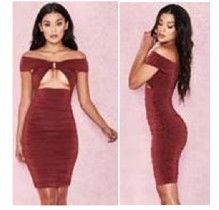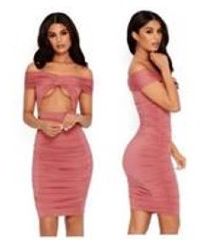Original Beauty Technology Company Ltd (OBTC) sells bodycon and bandage dresses under the main brand "House of CB" with a sister brand "Mistress Rocks".
OBTC sued G4K Fashion Ltd, who also sell bodycon and bandage dresses online, for infringement of unregistered design rights under UK and EU law in respect of 91 of their "Oh Polly" branded dresses (albeit the claim was limited to 20 dresses only by the time the case came to trial). OBTC also claimed that G4K had copied its business model, social media, marketing, packaging and presentation, such that consumers would be deceived into thinking that Oh Polly was a sister brand to House of CB, so as to amount to passing off.
G4K's main designer was Ms Claire Henderson (also the second defendant). Her evidence was that she designed by looking at trends from images she had collected, designed the details of each garment in her head, and then looked for images of existing garments that she could use to show the factory what it was she wanted made.
However, there was no evidence to corroborate Ms Henderson's version of her design process. Instead, the evidence showed that in each case, Ms Henderson had identified at least one garment (being either an OBTC garment or a third party garment), an image of which she emailed to colleagues or otherwise provided directly to the factory to be made up.
G4K also used a software program called "Trello", which tracked the development of a garment from design through to the end of manufacture. The evidence included images uploaded to Trello by Ms Henderson, including images of OBTC's garments.
Decision
Mr David Stone QC, sitting as a Deputy Judge of the High Court, considered Ms Henderson's version of her design process to be a fabrication, concocted to get around the very real difficulty that she had in fact taken images of OBTC's garments (and third party garments) and sent them to the factory to be made up.
UK Unregistered Design Right (UKUDR)
Mr Stone found that OBTC owned the UKUDR in the garments in question.
G4K admitted that an OBTC dress was referred to in the design process of nine of the 20 G4K garments in issue. As for the other eleven designs, OBTC argued that the judge should infer copying on the balance of probabilities because of: (i) the similarities between the designs, which suggested that copying had taken place; (ii) Ms Henderson's approach to design; (iii) the incomplete nature of the Trello records and the likelihood that Ms Henderson passed images directly to the manufacturers; and (iv) the likelihood that the OBTC garment alleged to have been copied existed in Ms Henderson's archive of images.
However, Mr Stone said that, absent striking similarities between the designs in relation to features that were not themselves well known, he did not think that reasons (ii) to (iv) were sufficient to prove copying, or to give rise to a presumption that G4K was required to rebut. The UKUDR claim in respect of these dresses therefore failed.
Community Unregistered Design Right (CUDR)
Applying the test set out in Cantel Medical (UK) Ltd v ARC Medical Design Ltd [2018] EWHC 345 (Pat), the judge found that: (i) the sector here was women's clothing; (ii) the informed user was a user of women's clothing, who was aware of bodycon and bandage dress fashions, including garments worn by celebrities and shown on social media, and would compare the designs directly; (iii) a garment had to be designed to be worn and to fit the body, but within those constraints, the designer had almost complete design freedom; (iv) it was not contended that any feature of any of the designs was solely dictated by technical function; and (v) some aspects of a garment, i.e. the front, would strike the informed user as more important; differences on the back of the garment would be noticed, but they would not be given the importance of the front of the garment.
As for ownership, Mr Stone found, again, that OBTC was the owner. He also came to the same conclusions on copying as in relation to UKUDR.
Infringement
Mr Stone found that seven of the nine garments in which G4K admitted referencing the OBTC design and uploading it to Trello at the beginning of the design process infringed OBTC's UKUDR and CUDR in the garment design.
By way of example:
OBTC dress:

G4K dress:

The OBTC dress above was designed by an OBTC designer and first displayed on social media accounts in January 2018. Ms Henderson saw the dress on YouTube and took a screen shot, which she saved to her laptop. She then sent email instructions to her brother, who was also involved in the business, attaching images of the OBTC dress, together with a third party dress. Mr Henderson used software to remove the buckle shown on the OBTC image, uploaded it to Trello and sent the image to G4K's manufacturers to be made up, all in accordance with Ms Henderson's instructions. The G4K dress was first offered for sale on the Oh Polly website in March 2018.
G4K relied on the dress shown below, which was designed by Cushnie et Ochs (shown here worn by Karlie Kloss in an image taken from The Daily Mail Online in June 2016), to try and prove that the OBTC dress was not original in a copyright sense under UKUDR:

G4K also relied on a further six dresses to try and prove that the OBTC dress was commonplace.
In Mr Stone's view, the OBTC dress was not slavishly copied from the Cushnie et Ochs dress and did not produce the same overall impression on the informed user. As for the other six dresses, Mr Stone found that they were all different designs and did not make the OBTC design commonplace. Accordingly, the design right in the OBTC dress was not invalid in relation to UKUDR and CUDR.
Mr Stone had no hesitation in finding that the G4K dress was copied from the OBTC dress. As was clear from the evidence, Ms Henderson had downloaded an image of the OBTC dress from YouTube and instructed that it be sent to the factory to be reproduced.
Originally published April 9, 2021
The content of this article is intended to provide a general guide to the subject matter. Specialist advice should be sought about your specific circumstances.

